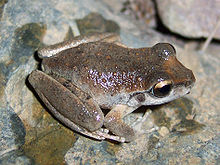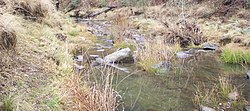Booroolong frog
| Booroolong frog | |
|---|---|

| |
| Scientific classification | |
| Domain: | Eukaryota |
| Kingdom: | Animalia |
| Phylum: | Chordata |
| Class: | Amphibia |
| Order: | Anura |
| Family: | Hylidae |
| Genus: | Ranoidea |
| Species: | R. booroolongensis
|
| Binomial name | |
| Ranoidea booroolongensis (Moore, 1961)
| |

| |
| Current distribution of the Booroolong frog (in black) compared to the historic distribution (in grey). | |
| Synonyms[3] | |
| |

The Booroolong frog (Litoria booroolongensis) is a species of stream-dwelling frog native to the
Description
Physical
Adults
This frog is a medium-sized frog, with the females reaching about 55 mm (2.2 inches) of snout-to-vent length (SVL) and the males reaching about 40mm (1.6 inches) SVL. It has a rounded snout and a marginally wider head. Its smoothly-textured dorsal side is normally of grey, olive, or reddish-brown colour with dark reticulations and lighter-coloured speckles, while its ventral surface is light or cream-coloured with a higher level of granularity. Male frogs exhibit dark specks on the throat. The frog is typically slightly warty in appearance, with grey-coloured flanks. The posterior of the thighs are dark-brown and patterned with yellow and black reticulations. A faint dark stripe runs from the nostril, through the eye, and encircles the darkly-coloured tympanum before ending at the shoulder; this stripe is pale and thin in contrast to the closely related stony creek frog and Lesueur's frog, and can be used to distinguish between the species. The armpit is also pale yellow. It has brightly golden-coloured eyes with a dual-shaded iris. The finger and toe discs are relatively well developed and of moderate size, with the length of the second finger exceeding the length of the first. The toes are nearly fully webbed while the fingers lack any form of webbing.[5]
Tadpoles
The tadpoles develop into a streamlined, or elongated, shape and reach a length of 50mm (2 inches) preceding their complete metamorphosis, which occurs over an average period of 75 days in the summer. Similar to the metamorphised adults they have a rounded head with golden eyes, although the sides of the iris are more shaded. The mouth is located on the ventral surface with reasonably-spaced nostril cavities. The tadpoles' dorsal side is of a dark rusty-brown colour and is patterned with shaded mottling that advances along the tail. There is a dark-brown coloured band across the lower dorsal surface, and the sides present as the same rusty-brown colour but with a metallic copper sheen. In opposition, the ventral surface presents with a golden sheen albeit some darker splotches. The tail itself is of thick muscle that narrows as it approaches the rounded tip, and the tadpoles have a non-arched ventral fin.[5]
Species
Due to genetic differences found within the Northern Tableland populations and the Central/Southern Tableland populations, some studies have indicated that the lineages should be considered separate evolutionary significant units (ESUs). While current data on genetic and morphological features of the two populations suggests that they fall under the description of a singular species, more research is being conducted so as to evaluate the degree of divergence and whether or not this warrants a classification of two separate subspecies.[5]
Behaviour
General
Adults
Generally the Booroolong frogs are stagnant creatures, preferring not to leave the streams into the adjoining landscape. Within a breeding season, individual frogs typically move less than 50m.[5] Booroolong frogs are at their most active during the night, although they can occasionally be found positioned on rocks and basking in the sun beside the stream during the daytime, especially during the summer months.[4][5] Individuals also enjoy sheltering within cave crevices, grass, or logs. This sheltering occurs with both juvenile and adult frogs within the winter months.[5]
Tadpoles
Through adaptations to withstand riverine environments, tadpoles are capable of withstanding strong and fast river flows. Additionally, they are able to survive in a variety of water qualities and have been found in streams offsite of agriculturally-developed land. Generally, they feed on organic detritus such as algae.[5]
Reproductive
Males make a quiet "quirk...quirk...quirk" purring call, which occurs for two to three seconds,[5] from beside streams or on bedrock within streams beginning in August, or late winter, through to summer. The species has a high fecundity and a lengthy breeding period. To attract a mate, individuals leave their daytime sheltering sites to call in more exposed areas alongside the stream, but then often retire back to their original sheltering site. An average of about 1,300 eggs are laid in a single adherent clump, attached to or under rocks, within rock pools, or in still sections of streams. Hatching occurs from four to seven days after laying.[5] Tadpoles from northern areas that have completed metamorphosis, or metamorphs, average about 15 mm (0.59 inches), while those in the south measure about 22 mm (0.87 inches). When in captivity, metamorphosis occurs after 75 days, and metamorph frogs closely resemble the adult.
Habitat

This species is a stream-dwelling frog, occurring in rocky westerly flowing rivers and streams in highland areas on the Great Dividing Range. These streams are characterised by their borders of grassy vegetation and slow-flowing water. Their habitat is normally associated with open woodlands, but they can also be found in grassland and temperate forest streams, including waterfalls. The permanent flow of water is a necessity for the survival of the species, and ephemeral streams are uninhabitable. Generally, Booroolong frogs greatly prefer headwater streams with a variety of rock sizes, aquatic rock crevices and islands, pools, and rock/gravel rapids. They also prefer areas with a greater level of exposure to sunlight.[5]
Distribution
The Booroolong frog was distributed along eastern Australia, ranging from the Queensland border to the Victorian Border.
As of February 2023[update], the species was reported to exist only in the Southern and Central Tablelands of NSW. However, recent floods (2022) had boosted the population.[6]
Ecology
The Booroolong frog plays an important part in the ecosystem by being predators of pest species, and serving as food for native bird and reptiles.[6]
Conservation
The Booroolong frog, as of its 2004 IUCN Red List global assessment, has a conservation status listed as Critically Endangered. Its status was justified due to a continuous decline in habitat, both in quality and extent, as well as a critically fragmented distribution range and a low number of mature individuals.[4]
Declines in population have been the most prevalent within the Northern Tableland region, with the majority of the subpopulations being extirpated entirely. This has caused the Northern population to approach complete regional extinction.
The Booroolong frog was assessed to meet the criteria for endangerment under the EPBC Act in five locations:[5]
- Glenn Innes, NSW
- Naomi catchment, Hunter catchment, and Manning catchment
- Central West catchment
- Murrumbidgee catchment
- Murray catchment
Over the 40 years prior to 2023, it was estimated that numbers had been dropping until there were only around 5,000 frogs left in the wild.[6]
Threats
The declining numbers of the species are due to a variety of threats, most of which are either direct or indirect consequences of human intervention. Direct consequences stem from agricultural practices such as wood/pulp plantations and livestock farming, as well as human manipulation of the natural environment such as mining/quarrying practices, dams, and other water management techniques. Although many of these techniques are now out of practice, they have resulted in consequences that are still ongoing today, such as changes to the stream's flow, as well as the introduction of new fish species which exert predatory pressure on the Booroolong tadpoles. Indirect consequences also often stem from these human interventions, including forest and water pollution as well as climate change-created droughts. Since the Booroolong frog is reliant on flowing-water to breed, their populations are exceptionally liable to droughts.[5] In addition to human-created threats, the Booroolong frog is facing environmental threats such as invasive diseases.[4] Introduced species of tree such as the willow have also destroyed habitat.[6]
Specifically, the species is suffering the most widespread decline as a result of Batrachochytrium dendrobatidis, or Bd, a parasitic chytrid fungus which causes a fungal infection of the skin, known as chytridiomycosis, inhibiting the frog from maintaining osmotic balance.[7] Frogs exposed to Bd do not develop immunity, and can suffer from repeat infections.[5] A 2010 study ran by M. McFadden indicated a large record of chytridiomycosis within the released population of captive-bred frogs. Within the study, 610 two- to four-month-old captive-bred Booroolong frogs were released in a 1.5km section of a creek and then monitored intermittently over the course of two years. Following observation, 105 frogs were re-captured with only 29 surviving to reach sexual maturity and participate in breeding behaviours.[8] Another naturally-occurring threat that diminishes the Booroolong frog population is the increased frequency of bushfires. These bushfires create increased water temperatures as well as sedimentary runoff which fills in rock crevices and reduces areas of refuge in areas even 80km downstream.[5] While these threats have all been individually rated as a 3 (low impact) on the IUCN impact scale, their combined destruction is responsible for the large reduction in population.[4]
Efforts
The range of the Booroolong frog covers multiple protected areas, and while there has been some development of a management plan, further research, existing population protection, and habitat rehabilitation is necessary to prevent a further decline and eventual extinction.[4]
The
The plans to prevent habitat disturbance involve using habitat modeling to identify essential population areas and ensure their protection while increasing breeding opportunities by maintaining the persistence of stream-flow. Many of the plans place a focus on reforming and setting limitations on human habitat intervention, such as by minimising inappropriate usage of heavy machinery, ensuring quality road construction, and designating protection zones which encircle breeding sites.[5] Prevention of access to waterways by lifestock is also an important conservation measure.[6] In an effort to develop a better response to bushfires, plans include ensuring the protection of unburnt areas adjacent to areas impacted by the fire, as well as conducting surveys to establish a baseline of population response. To manage the impacts of invasive species, there are set-movements towards trout-stocking restriction/eradication as well as using fencing around the Booroolong frogs' habitats or other preventative measures. In efforts to minimise the spread of Bd, the recovery plan encourages a further investigation into the frogs' Bd resistance. The identified resistance mechanics would then have the potential to be utilised in selective breeding efforts, creating and releasing Bd-resistant frogs. Additionally, protocols to prevent against the spread of Bd such as improved disease identification and adoption of enhanced hygiene practices would be set into place.[5]
Generally, the plan involves close monitoring of the Booroolong frogs, identification of threats, and adoption of captive breeding methods where possible. Following the expiry of the plan, however, there is no recommendation from the Committee to develop a new plan, as it was deemed to have no critical conservation advantage.[5]
References
- The IUCN Red List of Threatened Species. 2004: e.T41029A10390615. Retrieved 29 January 2020.
- ^ Moore, John Alexander (1961). "The frogs of eastern New South Wales". Bulletin of the American Museum of Natural History. 121: 153–385.
- ^ Frost, Darrel R. (2020). "Ranoidea booroolongensis (Moore, 1961)". Amphibian Species of the World: an Online Reference. Version 6.0. American Museum of Natural History. Retrieved 29 January 2020.
- ^ .
- ^ a b c d e f g h i j k l m n o p q r s t u v w Threatened Species Scientific Committee (19 October 2021). Conservation Advice Litoria booroolongensis (PDF). Australian Government. pp. 1–24.
- ^ a b c d e Cole, Hamish (23 February 2023). "Booroolong frogs bounce back after habitat restoration and cleansing floods". ABC News (Australia). Retrieved 22 August 2023.
- ^ "GISD". www.iucngisd.org. Retrieved 6 December 2022.
- ^ "- Conservation Evidence". www.conservationevidence.com. Retrieved 6 December 2022.

